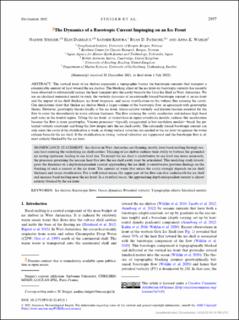| dc.contributor.author | Steiger, Nadine | |
| dc.contributor.author | Darelius, Elin Maria K. | |
| dc.contributor.author | Kimura, S | |
| dc.contributor.author | Patmore, Ryan Declan | |
| dc.contributor.author | Wåhlin, A. K. | |
| dc.date.accessioned | 2022-12-20T14:19:22Z | |
| dc.date.available | 2022-12-20T14:19:22Z | |
| dc.date.created | 2022-08-23T15:37:55Z | |
| dc.date.issued | 2022 | |
| dc.identifier.issn | 0022-3670 | |
| dc.identifier.uri | https://hdl.handle.net/11250/3038899 | |
| dc.description.abstract | The vertical front of ice shelves represents a topographic barrier for barotropic currents that transport a considerable amount of heat toward the ice shelves. The blocking effect of the ice front on barotropic currents has recently been observed to substantially reduce the heat transport into the cavity beneath the Getz Ice Shelf in West Antarctica. We use an idealized numerical model to study the vorticity dynamics of an externally forced barotropic current at an ice front and the impact of ice shelf thickness, ice front steepness, and ocean stratification on the volume flux entering the cavity. Our simulations show that thicker ice shelves block a larger volume of the barotropic flow, in agreement with geostrophic theory. However, geostrophy breaks locally at the ice front, where relative vorticity and friction become essential for the flow to cross the discontinuity in water column thickness. The flow entering the cavity accelerates and induces high basal melt rates in the frontal region. Tilting the ice front, as undertaken in sigma-coordinate models, reduces this acceleration because the flow is more geostrophic. Viscous processes—typically exaggerated in low-resolution models—break the potential vorticity constraint and bring the flow deeper into the ice shelf cavity. The externally forced barotropic current can only enter the cavity if the stratification is weak, as strong vertical velocities are needed at the ice front to squeeze the water column beneath the ice shelf. If the stratification is strong, vertical velocities are suppressed and the barotropic flow is almost entirely blocked by the ice front. | en_US |
| dc.language.iso | eng | en_US |
| dc.publisher | AMS | en_US |
| dc.rights | Navngivelse 4.0 Internasjonal | * |
| dc.rights.uri | http://creativecommons.org/licenses/by/4.0/deed.no | * |
| dc.title | The dynamics of a barotropic current impinging on an ice front | en_US |
| dc.type | Journal article | en_US |
| dc.type | Peer reviewed | en_US |
| dc.description.version | publishedVersion | en_US |
| dc.rights.holder | Copyright 2022 American Meteorological Society | en_US |
| dc.source.articlenumber | 2957–2973 | en_US |
| cristin.ispublished | true | |
| cristin.fulltext | original | |
| cristin.qualitycode | 2 | |
| dc.identifier.doi | 10.1175/JPO-D-21-0312.1 | |
| dc.identifier.cristin | 2045452 | |
| dc.source.journal | Journal of Physical Oceanography | en_US |
| dc.relation.project | Norges forskningsråd: 267660 | en_US |
| dc.relation.project | Sigma2: NS9481K | |
| dc.relation.project | Sigma2: NN9481K | |
| dc.relation.project | Sigma2: NN9608K | |
| dc.relation.project | Sigma2: NS9608K | |
| dc.identifier.citation | Journal of Physical Oceanography. 2022, 52 (12), 2957–2973. | en_US |
| dc.source.volume | 52 | en_US |
| dc.source.issue | 12 | en_US |

